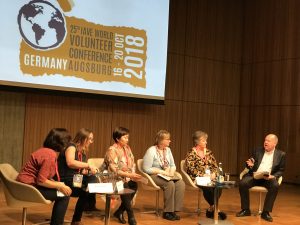 Every two years, the International Association for Volunteer Effort (IAVE) organizes the World Volunteer Conference. The 25th convening took place in Augsburg, Germany, outside of Munich, where I moderated two panels. Seven hundred delegates from 94 countries participated. Adjacent to the conference was the Global Corporate Volunteer Council (GCVC).
Every two years, the International Association for Volunteer Effort (IAVE) organizes the World Volunteer Conference. The 25th convening took place in Augsburg, Germany, outside of Munich, where I moderated two panels. Seven hundred delegates from 94 countries participated. Adjacent to the conference was the Global Corporate Volunteer Council (GCVC).
A topic that ran through many sessions, including one that I moderated, was technology. With recent regulations around data privacy, including the General Data Protection Regulation (GDPR), technology was top of mind. In particular, conference attendees asked: How do you have a virtual volunteer program that is global when information needs to cross borders and oceans? Other issues that continued to be central concerns include:
- Youth online protection
- New data protections in contrast with the need for heightened access to tech
- How to use tech more effectively with volunteers.
Virtual volunteering
Mercy Corps’ MicroMentor virtual volunteer program is a great way for business professionals to share their knowledge to help entrepreneurs in the developing world. The organization notes: “One of the most powerful ways of creating economic opportunity is to share relevant knowledge to help entrepreneurs succeed at their business. If you have expertise that would be helpful to a small business, you can connect virtually with thousands of entrepreneurs around the world and start mentoring.”
Another interesting virtual volunteering project lets volunteers research accessible buildings with wheelchair ramps and other amenities and then tag them on maps that can be easily used by those with mobility challenges. Also, translating books and articles or digitizing printed materials can be done from anywhere.
WhatsApp continues to amaze me. An economic as well as technology solution, it’s especially important in the developing world to connect people and promote volunteering. For example, a colleague from Sudan uses the WhatsApp to organize regional volunteer coordinators and volunteer projects.
Challenges abound for tech solutions
Despite significant advances in tech for volunteering and philanthropy, there continue to be challenges for the technology platforms that run corporate volunteer programs, employee giving and grantmaking, especially with those that seek to make global philanthropy easier. Various regulations around the globe, including the Foreign Corrupt Practices Act (US), Foreign Contribution Regulation Act (India), Anti-Money Laundering (Mexico), Foreign NGO Law (China), and many other regulations, plus currency fluctuations, GDPR and the cost of due-diligence, continue to make giving globally a challenge.
SDGs
The world is seeing more religious conflicts, generational differences, new diseases, a greater divide between the haves and have nots, and refugee crises. To counter these challenges, we need deeper and more involved solutions. This is where the Sustainable Development Goals (SDGs) come in. The SDGs were also a central topic at both the IAVE conference and council meeting. Oliver Adams, who leads United Nations Volunteers (UNV), addressed the conference on the progress of the Global Goals and the need to step up our efforts to achieve them by 2030.
The SDGs are informing companies’ work by helping them evolve from transactional to transformational initiatives, spark cocreation with multi stakeholders, look at the long term, form collaborative agreements with mutual accountability, become outcomes and impact oriented, and work towards systemic change.
The other session I moderated was called “Taking your volunteer program to the next level.” We addressed several questions, including:
- Once you have an excellent and engaging employee volunteer program, what else can you do?
- How do you improve the program and take it to the next level?
- How do you create more impact for communities, for employees, and for the company?
- Can you make it transformative?
Employee volunteer managers are now cognizant of transactional costs for NGOs and are helping to reduce them, as companies shift their focus from delivering hours to impact. Companies are also changing the way they design volunteer programs to respond to employees’ views of how they want to reshape the world, rather than the view of the company. Doing this provides the opportunity for sustained engagement.
Volunteering with refugees
It was heartening to hear some of the European company representatives talk about their programs to help with the refugee crisis and the new immigrants to their countries. For example, employee volunteers are working to help assimilate refugees by being coaches and mentors, answering questions and directing them to necessary services. In this way, these volunteer projects are similar to a buddy program.
Throughout these convenings, there was a lot of discussion about new challenges and the opportunities they provide to better engage employees in solving critical issues. I left optimistic, having witnessed the movement towards resilient, inclusive, accountable, and successful communities.
Some key takeaways
- Ask the employees. The best way to discover what employees will want to participate in is to just ask.
- Create plannable goals. What would we like to achieve? These should mirror the process for financial goals.
- Civic engagement instead of volunteer engagement is a trend.
- Volunteer themes quarterly keeps it fresh. Toolkits around the theme educate and suggest volunteer opportunities.
- Project Management Institute gives skills-based volunteer project managers professional development units (DPUs) to maintain their certificates.
First published by The Conference Board on November 14, 2018
